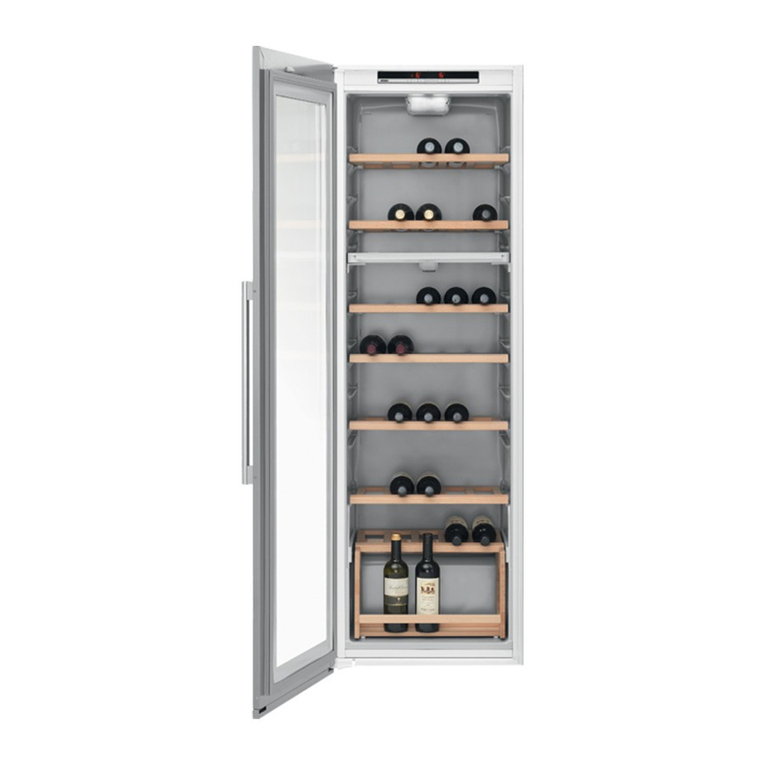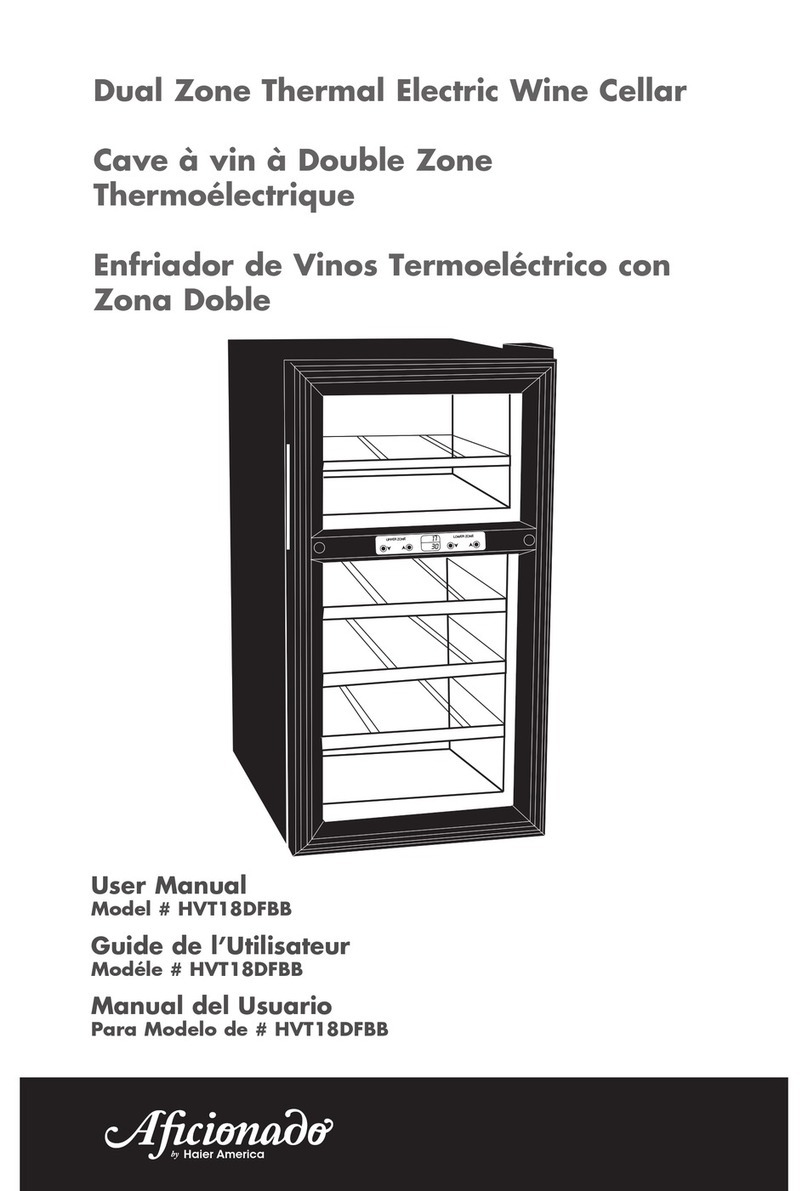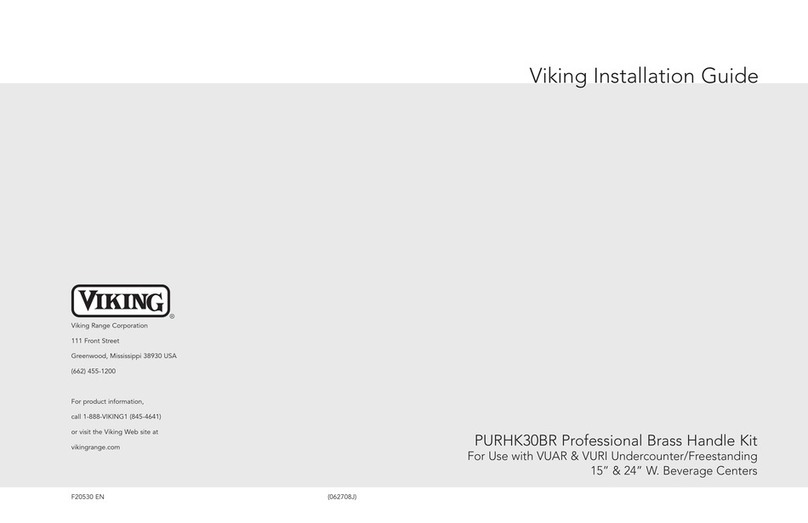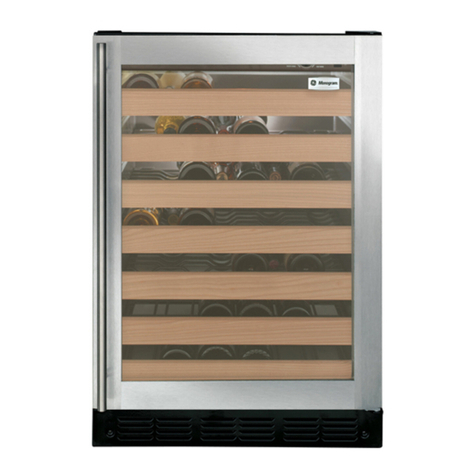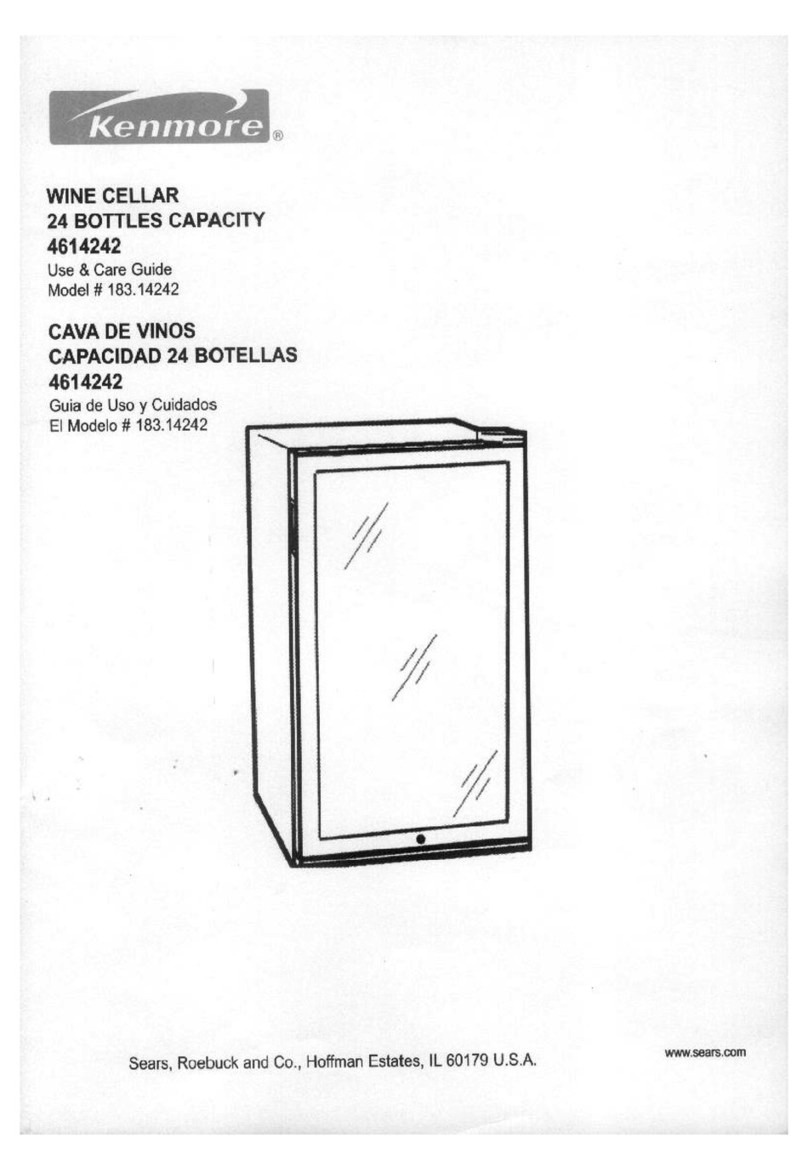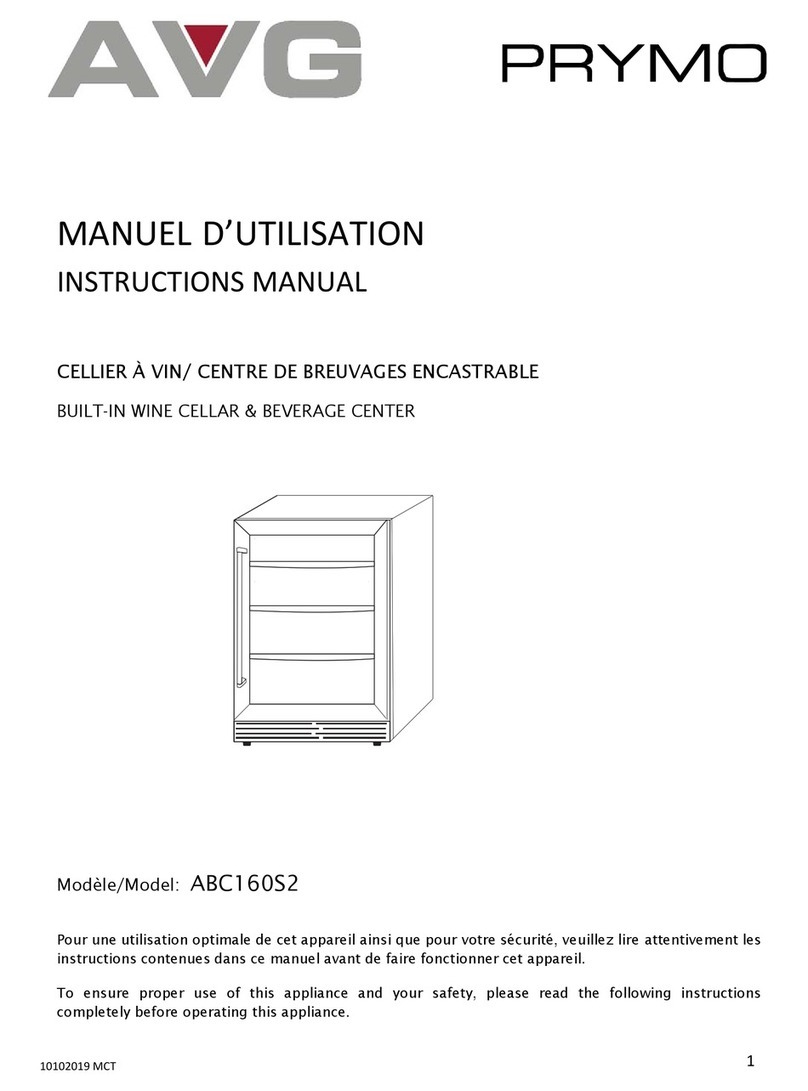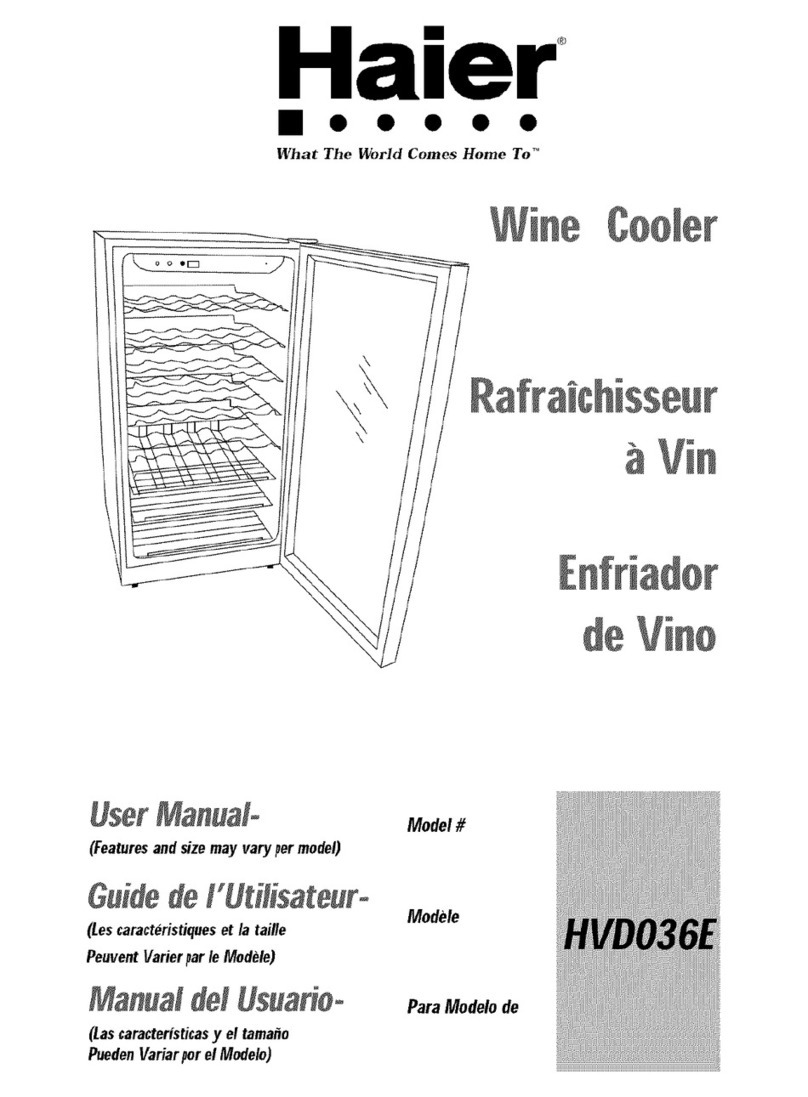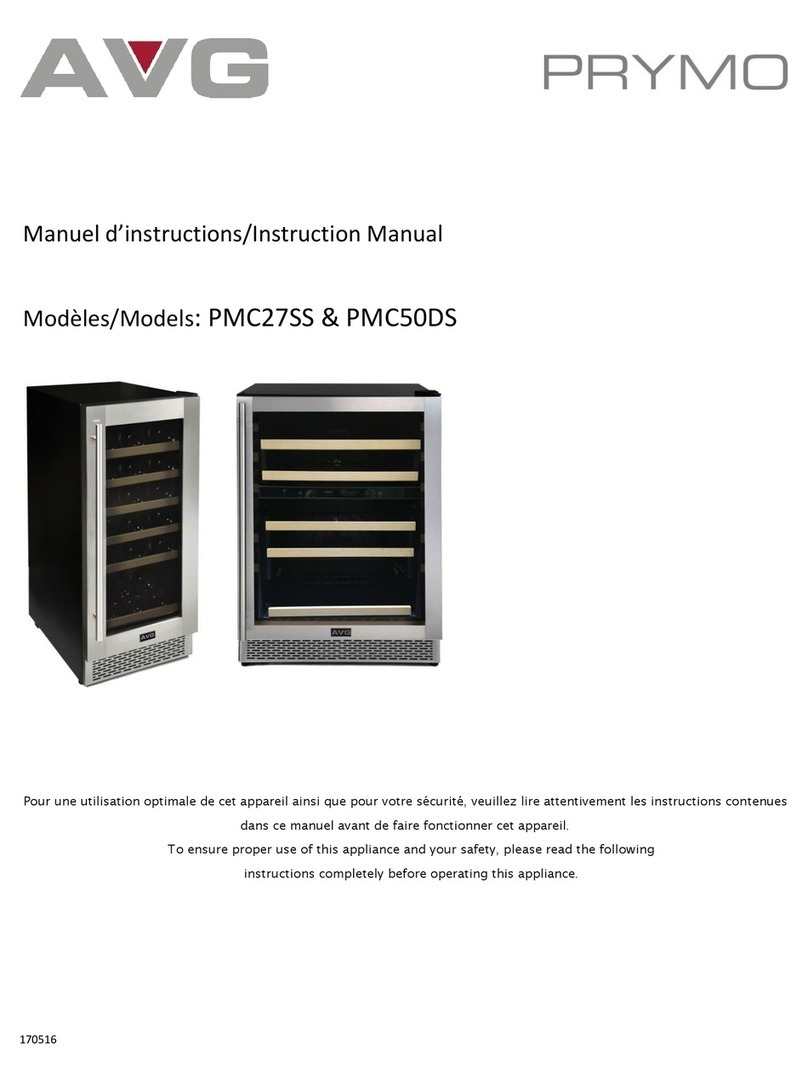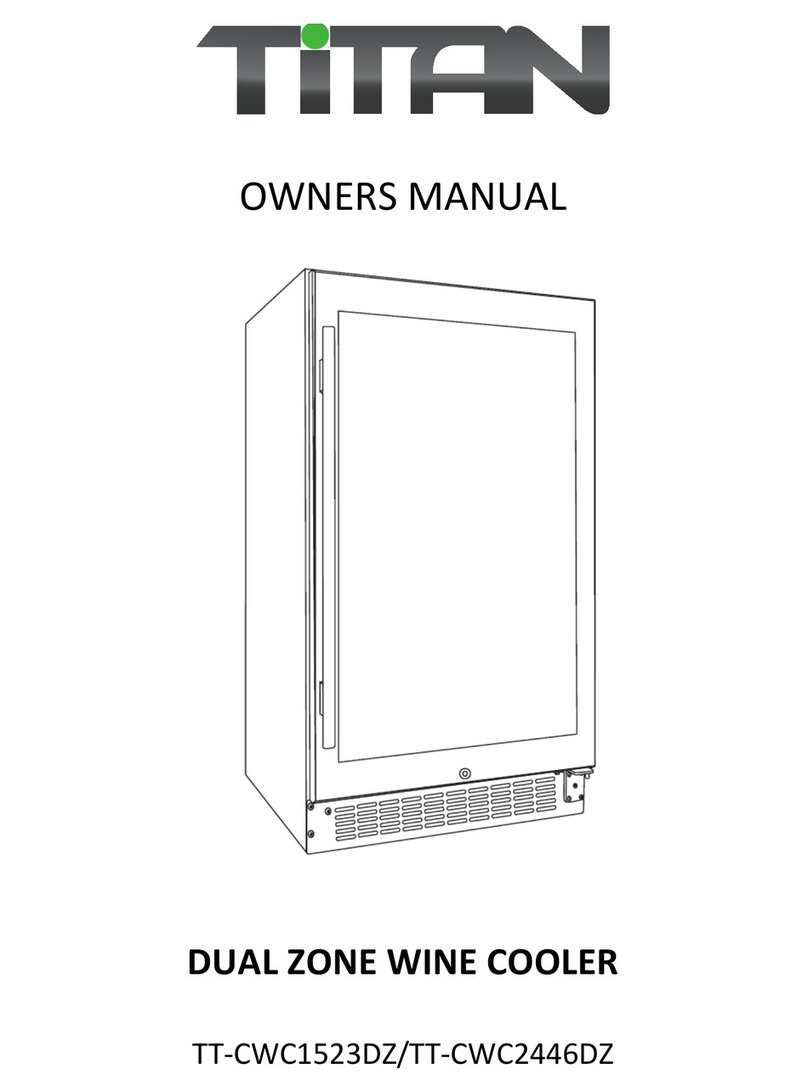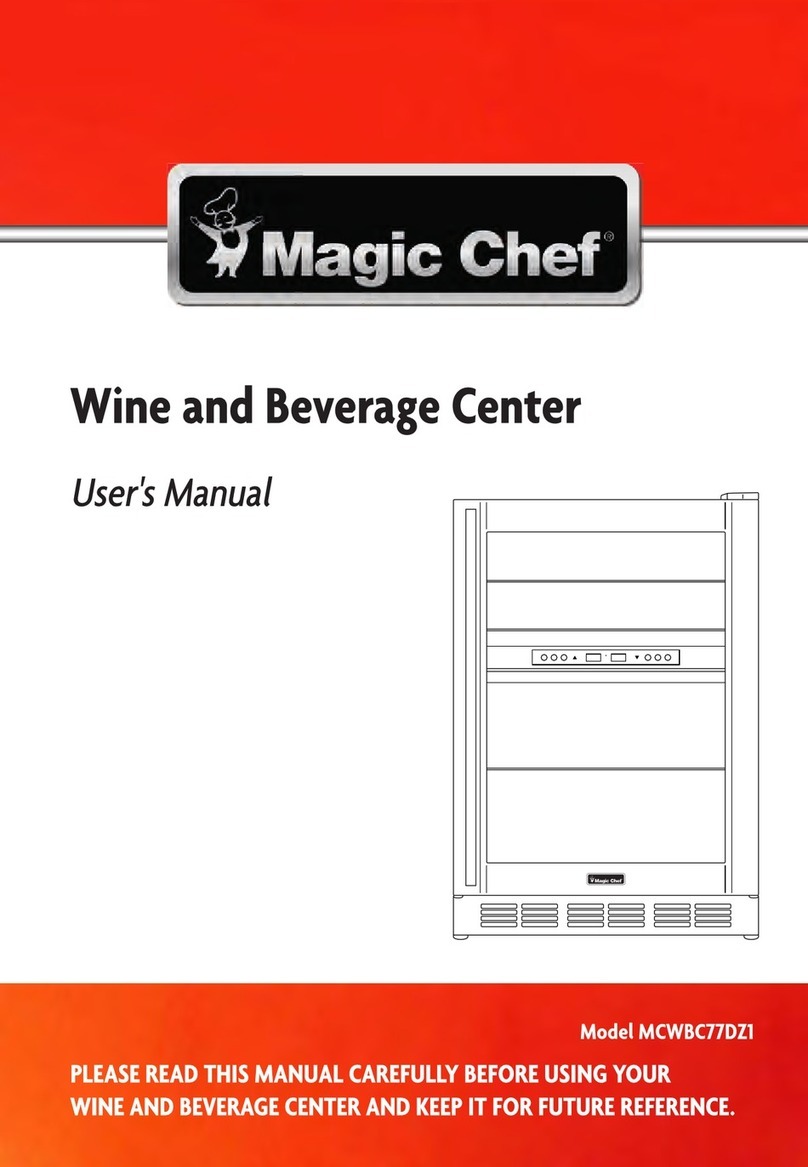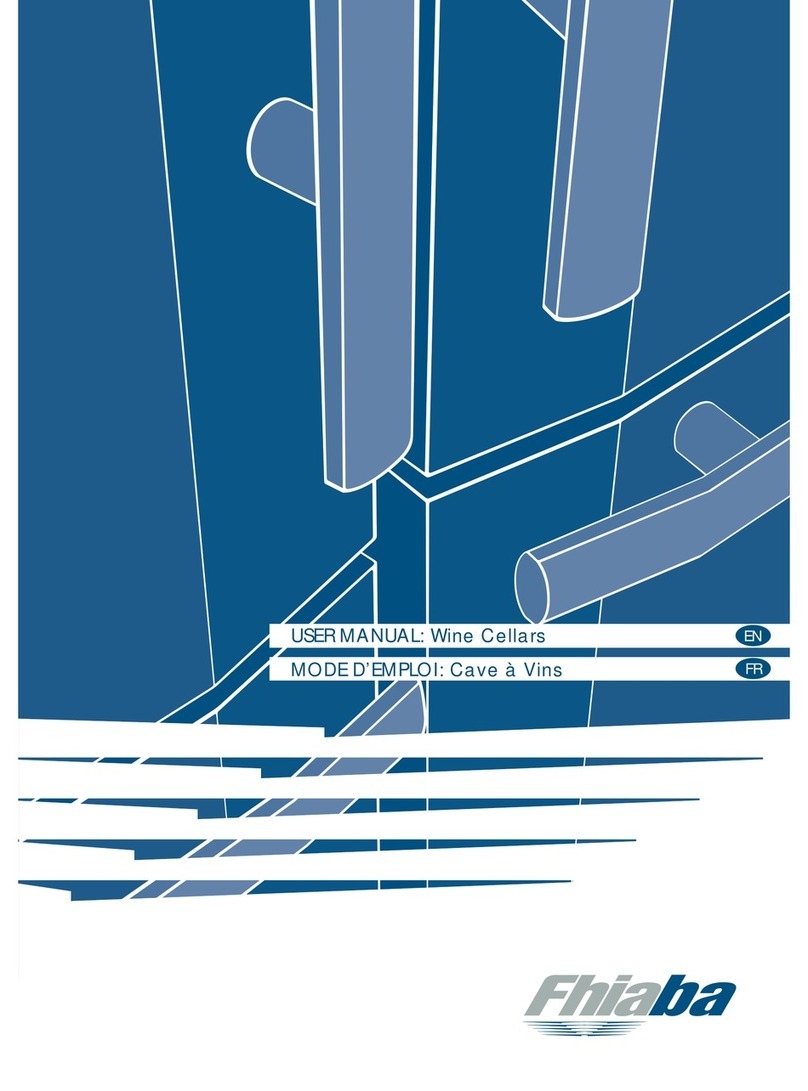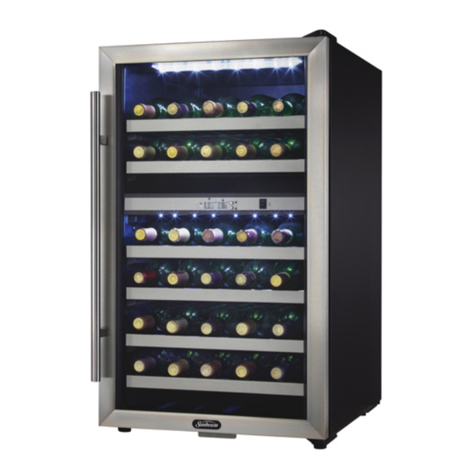Atag KU8571K2C User manual

INSTRUCTIONS FOR USE
WINE CLIMATE CABINET
EN
KU8574K2C
KU8571K2C

3Introduction ................................................
3Welcome to our growing Atag family! ..........
4Safety instructions .....................................
4Safety of children and vulnerable people .....
5General safety ..............................................
6Installation ....................................................
6Electrical connection ...................................
7Use ...............................................................
8Care and cleaning .......................................
8Disposal .......................................................
9Installation and connection ......................
9Selecting the location ..................................
9Appliance placement ...................................
11Connecting the appliance ...........................
12
Before using the appliance for the first
time ..............................................................
12
Before you use the appliance for the first
time ..............................................................
12Energy-saving advice ..................................
13Storing wine ...............................................
13Wine storage tips .........................................
14Storing bottles ..............................................
15Description of the appliance .....................
22
Humidity box (separate accessory, not
included) ......................................................
23Operation ....................................................
23Control panel ...............................................
24First use .......................................................
26Main displays ...............................................
28Appliance Display Standby .........................
28Key lock .......................................................
29Lock settings ................................................
29Alarms ..........................................................
31SETTINGS MENU .........................................
34Software update ...........................................
35Wi-Fi function ...............................................
36Charcoal filter countdown and notification ...
36Sabbath mode .............................................
37Eco mode .....................................................
38Maintenance ...............................................
38Defrosting the appliance .............................
38Cleaning the appliance ................................
39Reversing the door opening direction .....
46Installation of the appliance ......................
55Solving problems .......................................
55Tips & Tricks ................................................
56Error notifications .........................................
58Other display warnings ................................
59General problems ........................................
60Environmental aspects ..............................
60Disposal of packaging and appliance .........
Contents

Welcome to our growing Atag family!
We are proud of our appliances. We hope that this appliance will be an appreciated and dependable
aid for many years to come.
Please read the operating instructions before use. They include general tips, information about the
settings and adjustments you can make, and the best way to take care of your appliance.
Link to the EU EPREL database
The QR code on the energy label supplied with the appliance provides a web link to the registration
of this appliance in the EU EPREL database. Keep the energy label for reference together with the
user manual and all other documents provided with this appliance.
It is possible to find information related to the performance of the product in the EU EPREL database
using the link https://eprel.ec.europa.eu and the model name and product number that you can find
on the rating plate of the appliance.
For more detailed information about the energy label, visit www.theenergylabel.eu.
The following symbols are used throughout the manual and they have the following meanings:
INFORMATION!
Information, advice, tip, or recommendation
WARNING!
Warning –general danger
ELECTRIC SHOCK!
Warning –danger of electric shock
DANGER OF FIRE!
Warning –danger of fire
3
Introduction

Before the installation and use of the appliance, carefully read the
supplied instructions. The manufacturer is not responsible if an
incorrect installation and use causes injuries and damages. Always
keep the instructions with the appliance for future reference.
WARNING!
If the appliance is installed at an altitude of over 1000 m above
sea level, there is a danger of glass cracking due to air pressure.
In such case, glass fragments could cause injury.
Safety of children and vulnerable people
•The appliance is not intended for use by persons (including
children) with reduced physical, sensory or mental capabilities,
or lack of experience and knowledge, unless they have been
given supervision or instruction concerning use of the appliance
by a person responsible for their safety.
•Children should be supervised to ensure that they do not play
with the appliance.
•Cleaning and user maintenance shall not be made by children
without supervision.
•Keep all packaging away from children.
For European markets only
•This appliance can be used by children aged from 8 years and
above and persons with reduced physical, sensory or mental
capabilities or lack of experience and knowledge if they have
been given supervision or instruction concerning use of the
appliance in a safe way and understand the hazards involved.
•Children shall not play with the appliance.
•Cleaning and user maintenance shall not be made by children
without supervision.
•Children aged from 3 to 8 years are not allowed to load and unload
the appliance.
4
Safety instructions

General safety
•Illumination in the appliance is only suitable for illumination of this
appliance and not for household room illumination.
•WARNING! This appliance is intended to be used in household
and similar applications such as:
- staff kitchen areas in shops, offices and other working
environments;
- farm houses and by clients in hotels, motels and other
residential type environments;
- catering and similar non-retail applications.
WARNING!
Keep ventilation openings, in the appliance enclosure or in the
built-in structure, clear of obstruction.
Do not use mechanical devices or other means to accelerate the
defrosting process, other than those recommended by the
manufacturer.
Do not damage the refrigerant circuit.
Do not use water spray and steam to clean the appliance.
Clean the appliance with a moist soft cloth. Only use neutral
detergents. Do not use abrasive products, abrasive cleaning pads,
solvents or metal objects.
Do not store explosive substances such as aerosol cans with a
flammable propellant in this appliance.
If the supply cord is damaged, it must be replaced by the
manufacturer, its service agent or similarly qualified persons in
order to avoid a hazard.
To avoid a hazard due to instability of the appliance, it must be
fixed in accordance with the instructions.
5
Safety instructions

Installation
•Remove all the packaging.
•Do not install or use a damaged appliance.
•Obey the installation instruction supplied with the appliance.
•Always be careful when you move the appliance because it is
heavy. Always wear safety gloves.
•Make sure the air can circulate around the appliance.
•After you place the appliance, wait at least 4 hours before
connecting the appliance to the power supply. This is to allow the
oil to flow back in the compressor.
•Do not install the appliance close to radiators or cookers, oven
or hobs.
•Do not install the appliance where there is direct sunlight.
•Do not install this appliance in areas that are too humid or too
cold, such as the construction appendices, garages or cellars.
ELECTRIC SHOCK!
WARNING! When positioning the appliance, ensure the supply
cord is not trapped or damaged.
Electrical connection
ELECTRIC SHOCK!
WARNING! Risk of fire and electrical shock.
•The appliance must be earthed.
•All electrical connections should be made by a qualified
electrician.
•Make sure that the electrical information on the rating plate agrees
with the power supply. If not, contact an electrician.
•Always use a correctly installed shockproof socket.
•Do not use multi-plug adapters and extension cables.
6
Safety instructions

•Make sure not to cause damage to the electrical components
(e.g. mains plug, mains cable, compressor). Contact the Service
or an electrician to change the electrical components.
•The mains cable must stay below the level of the mains plug.
•Connect the mains plug to the mains socket only at the end of
the installation. Make sure that there is access to the mains plug
after the installation.
•Do not pull the mains cable to disconnect the appliance. Always
pull the mains plug.
WARNING!
Do not locate multiple portable socket-outlets or portable power
supplies at the rear of the appliance
Use
WARNING!
Risk of injury, burns, electrical shock or fire.
•Do not change the specification of this appliance.
•Do not put electrical appliances (e.g. ice cream makers) in the
appliance unless they are stated applicable by the manufacturer.
•Be careful not to cause damage to the refrigerant circuit. It
contains isobutene (R600a), a natural gas with a high level of
environmental compatibility. This gas is flammable.
•If damage occurs to the refrigerant circuit, make sure that there
are no flames and sources of ignition in the room. Ventilate the
room.
•Do not let hot items to touch the plastic parts of the appliance.
•Do not store flammable gas and liquid in the appliance.
•Do not put flammable products or items that are wet with
flammable products in, near or on the appliance.
•Do not touch the compressor or the condenser. They are hot.
7
Safety instructions

Care and cleaning
WARNING!
Risk of injury or damage to the appliance.
•Before maintenance, deactivate the appliance and disconnect
the mains plug from the mains socket.
•This appliance contains hydrocarbons in the cooling unit. Only a
qualified person must do the maintenance and the recharging of
the unit.
Disposal
WARNING!
Risk of injury or suffocation.
•Disconnect the appliance from the mains supply.
•Cut off the mains cable and discard it.
•Remove the door to prevent children and pets to be closed inside
of the appliance.
•The refrigerant circuit and the insulation materials of this appliance
are ozone friendly.
•The insulation foam contains flammable gas. Contact your
municipal authority for information on how to discard the appliance
correctly.
•Do not cause damage to the part of the cooling unit that is near
the heat exchanger.
8
Safety instructions

Selecting the location
Place the appliance in a dry and well aired
room. The permitted ambient temperature
range for the appliance depends on the
appliance’s climate class, which is shown on
the type plate.
WARNING!
Do not place the appliance in a room where the temperature can fall below 5 °C: the appliance
may not work properly or become defective!
Relative humidityAmbient temperature range °CClassDescription
≤75%
+10 to +32SNExtended temperate
+16 to +32NTemperate
+16 to +38STSubtropical
+16 to +43TTropical
•In environments with high humidity level, condensate droplets may appear on the appliance’s
exterior surfaces.
WARNING!
Install the appliance in a room with an adequate amount of air. There should be at least 1 m3of
air per every 8 grams of refrigerant. The amount of refrigerant is indicated on the rating plate
inside the appliance.
WARNING!
Do not place the appliance in a room where temperature can drop to below 5°C. In such
environment, the appliance may not operate correctly, or it may become defective.
Appliance placement
In order to safely install the appliance and for the appliance to operate correctly, it is important to
place it onto a surface with adequate load-bearing capacity. If necessary, consult an architect/
structural engineer. The surface should be smooth and level with the floor in the room.
When the appliance is placed on the intended surface, it should be completely level in order to
decrease vibration.
9
Installation and connection

•Place the appliance at least 50 mm away from an electric or gas stove, and at least 300 mm
away from a heat source (e.g. a radiator or a heater). If such clearance is not possible, then
install an insulation panel.
•Do not expose the appliance to direct sunlight.
•At the base of the kitchen unit intended for building in the integrated appliance, there should be
at least 400 cm2free space, for adequate air circulation. Ventilation openings must not be covered
in any case!
10
Installation and connection

•When the appliance is installed, its plug
should always be accessible!
Connecting the appliance
•Connect the appliance to the power supply with a plug. The socket must be earthed. The nominal
voltage and frequency required for the appliance are shown on the appliance’s type plate/label
with basic information.
•The appliance must be connected to the mains and earthed in accordance with the prevailing
standards and regulations. The appliance can withstand small variations in the mains voltage
to a maximum of plus or minus 6%.
WARNING!
When you are not going to use the appliance for a longer period then switch it off (with function
ON/OFF) and disconnect it from the mains. Empty and clean the appliance, than leave the door
ajar.
11
Installation and connection

Before you use the appliance for the first time
Do not connect the appliance to the mains until you have carefully read the instructions for the correct
and safe use of the appliance. We recommend that you keep these instructions for future use. If you
sell the appliance, enclose them with the appliance.
Inspect the appliance for damage and/or irregularities. If the appliance is damaged, contact the
store that sold you the appliance.
Allow the appliance to stand upright for at least 4 hours before you connect the appliance to the
mains. This reduces the risk of malfunctions resulting from transport effects on the refrigerant unit.
Before using the appliance for the first time, the interior and all internal accessories should be cleaned
with lukewarm water and a neutral cleaning agent. Wipe the cleaned parts with a cloth with clean
water and then dry them thoroughly.
Clean the wooden parts with a damp cloth. Make sure the wood is not too wet and leave the parts
to fully dry before returning them to the appliance.
Energy-saving advice
•Install the appliance as stated in the instructions for use.
•Continuous use of ECO mode is recommended.
•Do not open the door more than necessary.
•Do not cover or block the ventilation slots.
•Replace a damaged door gasket or a gasket that no longer provides a perfect seal as soon as
possible.
•When placing bottles on the shelves, make sure the air can freely circulate around them (observe
the recommendations from the instruction manual and do not place more bottles on the shelves
than recommended or indicated).
•In case of a power supply failure, leave the door closed as long as possible to maintain the
temperature inside the appliance.
12
Before using the appliance for the first time

Wine storage tips
Natural wine cellars are the ideal place to store wine, because of the scarce light, the lack of vibrations
and having a special climate. A wine’s temperature determines its flavour, and influences enjoyment.
Wine ageing depends on the environment conditions in which the wine is stored. By maintaining
constant optimum temperature, correct air humidity, and an atmosphere free from any odours, the
wine climate cabinet provides excellent conditions for storing your wine. It also provides an
environment free from harmful vibrations that could also affect the ageing process. Since every type
of wine has an optimum ageing time and climate, we suggest checking the recommended time to
open the bottle as advised by the winemaker.
Most people who drink wine, know you serve white wine and champagne chilled, and red wine on
room temperature. What people may not know that the "room temperature" that wine professionals
are referring to, is the temperature of wine caves in the Bordeaux region of France. Those caves are
about 13°C. A good wine climate cabinet, can keep your wines at a perfect serving temperature,
reducing the guesswork and sometimes the headache.
It is very important to maintain a constant temperature within the wine climate cabinet. In case of a
power failure, open the door as little as possible to maintain the temperature in the appliance interior.
A gradual increase in temperature will not have a negative impact on the wine.
The humidity should be between 50% and 80%. Too low humidity will result in a dry cork. Too high
humidity will cause mold. The Atag Wine Climate Cabinet provides excellent ventilation with clean
air which helps preventing damage to labels and corks during storage.
The humidity levels in wine climate cabinet are particularly important for long term wine storage and
ageing. Recommended temperature for wine ageing is between 11°C and 13°C. For that purpose,
the wine climate cabinet will maintain optimal ageing conditions and notify the user, if the conditions
deviate from them. Extremely high and low temperature settings are intended mainly for the wine
serving purposes. Wine is exposed to this conditions for shorter time periods and therefore humidity
should not have any negative effect on the wine. However, monitoring of relative humidity levels is
available regardless of the compartment temperature setting.
Major temperature changes can cause humidity levels to deviate from the desired levels and it may
take longer, e.g. about a week, for them to stabilize again. During this time, the notifications for
humidity out of zone will not appear.
Extremely diverse settings in neighboring zones, e.g. A=20°C / B=5°C , A=5°C / B=20°C, may result
in the humidity levels not reaching the desired levels in the warmer compartments.
Wine should be stored horizontally, especially corked wines. It will keep the cork moist and swollen
and prevent wine from unwanted contact with air. Short term storage, within some weeks, storing in
tilted position is preferred to keep the cork damp. If the position is too upward, the cork will dry out.
Screw and crown caps have less demands regarding the positioning.
The wine cabinet is fitted with an activated carbon filter which prevents odors that can pollute your
wines. The Activated Carbon filter is originally called HEGA filter (High Efficiency Gas Absorption).
It removes the gas molecules through a process of adsorption (not absorption). During adsorption,
the pollutants stick to the outside of the Activated Carbon filter.
By having your own wine climate cabinet in your house, this creates enjoyment of your wine on a
premium level like the wine came straight out of a real wine cellar.
13
Storing wine

Storing bottles
•Moving the bottles or excessive vibration can have a negative effect on the aging process and
thus on the wine’s flavour.
•Keep the bottles intended for daily use on the front half of the shelves. Keep the wines you intend
to store for a long time or age in the bottom part of the cabinet.
•Store the bottles horizontally, so that cork stoppers are also kept moist from within.
INFORMATION!
Mould can appear on bottle labels; this depends on the type of glue used for the label. Clean
the bottles and remove any residual glue.
INFORMATION!
White sediment can form on cork stoppers as a result of oxidation due to contact with air.
Wipe the sediment with a dry cloth. The sediment does not affect the quality of the wine.
14
Storing wine

This product contains a light source of energy efficiency class <G>.
1. Door sensor
2. Push-to-open door mechanism
3. Hidden handle
4. LED illumination
5. Wooden bottle shelf
6. Wooden shelf on the insulation barrier
7. Control unit with a TFT display unit
8. Insulation barrier
9. Charcoal filter
10. Chalkboard name tag
11. Wooden bottom bottle rack
12. 2-layered glass door with UV filter
Door sensor (1)
When you open or close the appliance door, light will change according to your preferences. They
can be set in SETTINGS MENU.
Door sensor error is detected, when door open time reaches 10 minutes. In that case light is turned
off.
Push-to-open door mechanism (2)
The mechanism can be activated for the first time when the appliance is installed and connected to
power.
INFORMATION!
Do not place any magnetic items in direct vicinity of the appliance door sensor (1), as this could
cause the door to open inadvertently. As the mechanism is in the middle of the appliance, reversing
the door opening direction does not affect its operation.
15
Description of the appliance

To open the door, push it slightly inwards on
the upper left side, then release.
The mechanism's push pin (a) moves forward,
and the door opens by approximately 6 cm.
Then, you can fully open the door. If you do
not open the door completely, it will
automatically close. The soft-close mechanism
gently closes the door.
INFORMATION!
If the door closes, at least 2 seconds have
to pass before it can be opened again.
INFORMATION!
When the door opens or closes, do not
block it or press it onto the push pin in any
way.
16
Description of the appliance

Hidden handle (3)
In case of power failure, when push-to-open
door mechanism is not operating, hidden
handle enables you to open the door.
LED illumination (4)
LED illumination is installed on the appliance ceiling. Owing to the use of LED illumination, the wine
will not be exposed to UV rays and heat. The intensity, color and time interval of LED illumination
can be changed in SETTINGS MENU.
Two light modes can be set and saved to use in different situations: Ambient mode and Functional
mode.
Ambient mode: its purpose is to blend into the living space ambiance. It will be activated when the
door is closed (default).
Functional mode: its purpose is to provide a clear view on the shelves. It will be activated when
the door is opened (default).
Each light mode consists of a combination of intensity and warmth. These settings can be changed
to your preferences. Light color can be changed in range of 2700K-5000K, light intensity can be set
from 0% to 100%.
The activating and deactivating of the modes in different situations can be set in SETTINGS MENU.
Wooden bottle shelf (5)
The shelves are placed on fully extendible telescopic rails. When closed, the shelves are retained
in place. The retention force of the shelf closing mechanism prevents the shelf from being accidentally
extended, while the full extension functionality allows easier handling of the bottles.
INFORMATION!
Be careful when pulling out the wooden shelves. Carefully pull out and push back the wooden
shelves in order not to expose the wine bottles to vibration.
Before removing any shelf from the appliance, the shelf should be completely empty.
Make sure the door is fully open before removing the shelves. This will prevent any damage to
the door gasket.
17
Description of the appliance

To remove a shelf from the appliance, fully
extend the telescopic rails (1), and then
vertically lift the shelf (2) to remove it from the
rails. When removing the shelf, you can
experience some resistance because of the
fixation with the pin on the front side.Take care
not to damage the door gasket.
To replace a shelf onto the rails again, use the
grooves (a, b) and pin (c) on the back and
front side of the shelf.
First, fully extend the telescopic rails. Using
the grooves (a) position the shelf onto the
hooks (d) on the back side of the rails (1).
Then, use the grooves (b) to position the shelf
onto the hooks (e) on the front side of the rails
(2).
Pin (c) enables additional fixing of the shelf.
Press the shelf and rails together, so that the
pin is fully seated in the hole (f).
This way you will not accidently push the
shelve off.
18
Description of the appliance

INFORMATION!
Before you start adding bottles to a shelf,
check once more whether the shelf is
correctly placed on the plastic holders. Up
to 8 Bordeaux bottles (0.75 l) can be
placed on each standard wooden bottle
shelf.
INFORMATION!
Higher humidity level inside the appliance
may cause the wooden parts to slightly
bend; this, however, will not affect their
functioning.
Wooden shelf on the insulation barrier (6)
The shelf can be partly extended (pulled out
from the appliance). The blocks on the cell
protect the shelf from being fully extended and
pulled out, which could result in the shelf falling
from the appliance.
To remove a shelf from the appliance, partly
pull it towards you (1) until the two grooves on
the shelf and the two blocks (left, right) on the
cell are aligned. Then, lift the shelf (2) and pull
it out from the appliance (3). Take care not to
damage the door gasket.
To replace the shelf, proceed with the same
steps in the opposite direction.
Control unit with a TFT display unit (7)
By pressing the keys on display unit, you can control the operation of the wine climate cabinet and
set certain functions according to your preferences.
19
Description of the appliance

Insulation barrier (8)
Insulation barrier separates the inside of the wine climate cabinet into two temperature zones: A and
B. That allows individual temperature settings for these two zones and storage of different type of
wine.
Charcoal filter (9)
Fresh air is drawn into the appliance interior through active charcoal air filter. This ensures freshness,
as well as absence of dust and odours. The fan then distributes the air evenly across the appliance
interior.
Replace the air filter approximately every 12 months. A notification will appear on the display to
remind you it is time to replace the filter.
To replace the air filter:
1. Rotate the filter in the clockwise direction
(1) and pull it out from the appliance.
2. Insert a new filtering insert into the filter
slot; then, rotate the filter anti-clockwise
until it clicks into place.
INFORMATION!
Charcoal air filter can be ordered as accessory.
For more informations refer to the local Atag dealer or to the Atag website of your country.
Chalkboard name tag (10)
Chalkboard name tags are supplied with the appliance. They can be installed at the front side of
each shelf. You can use chalk to indicate the wine stored on a particular shelf. The chalkboard name
tags can be wiped with a damp cloth.
20
Description of the appliance
This manual suits for next models
2
Table of contents
Other Atag Wine Cooler manuals
Popular Wine Cooler manuals by other brands
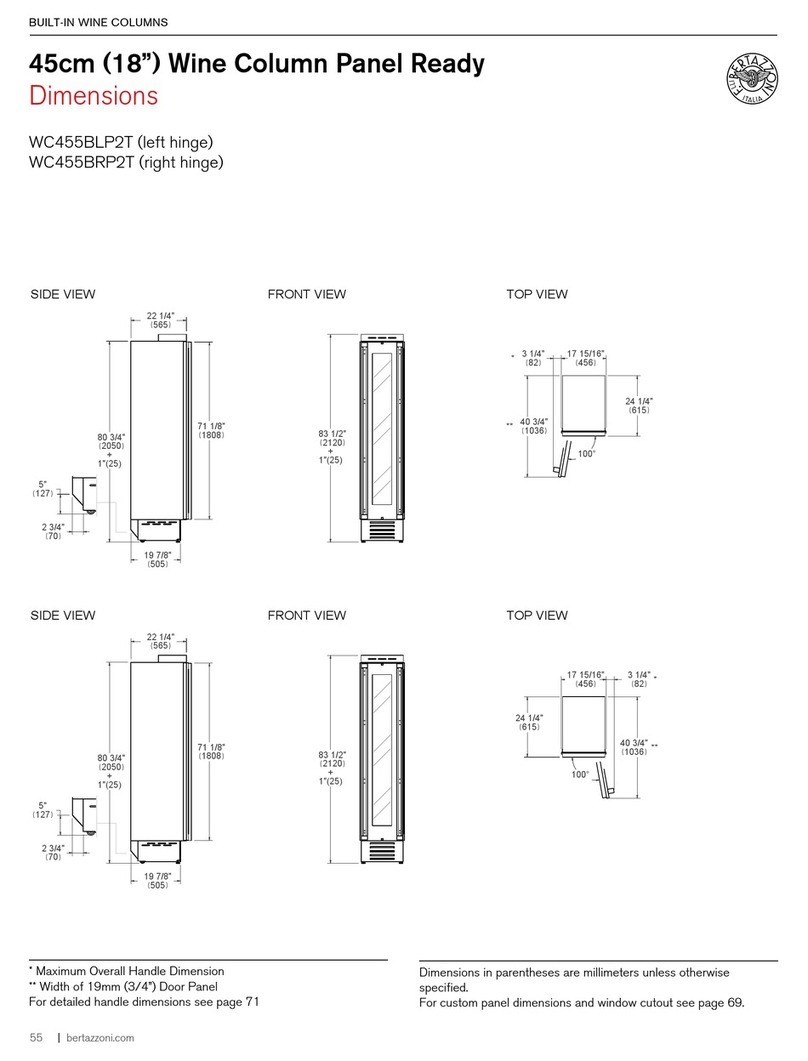
Bertazzoni
Bertazzoni WC455BLP2T quick guide

Franklin Chef
Franklin Chef FCW100 Use and care guide
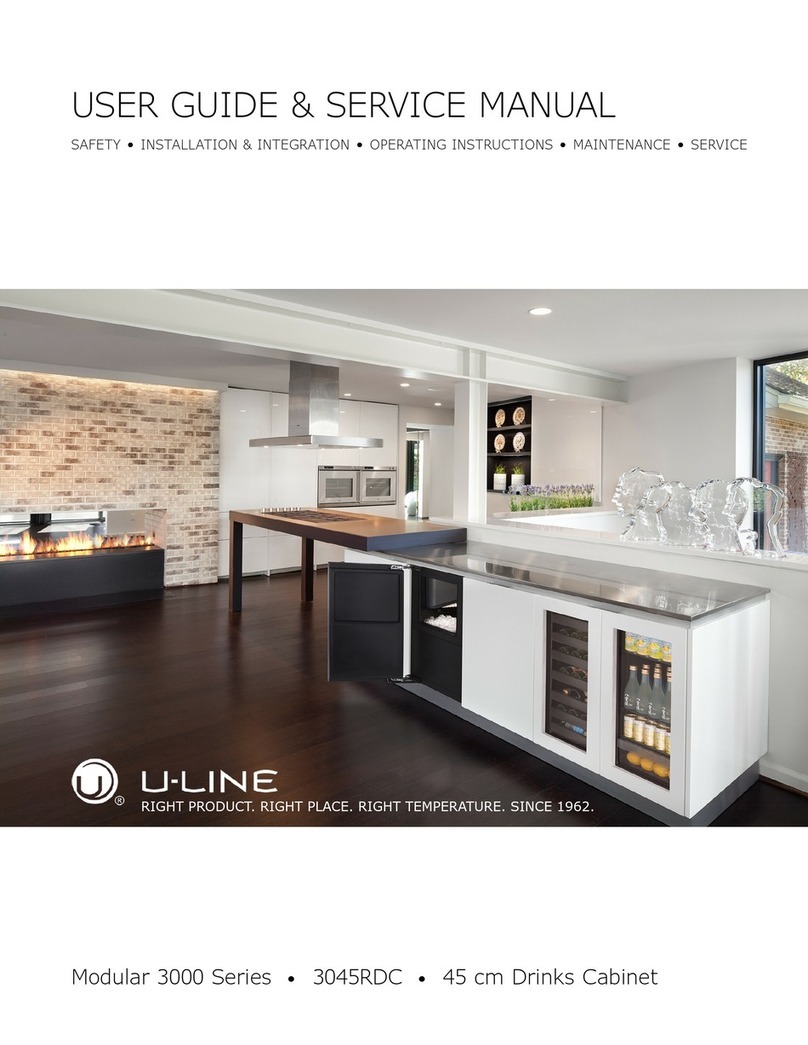
U-Line
U-Line U-3045RDCINT-00B User guide & service manual
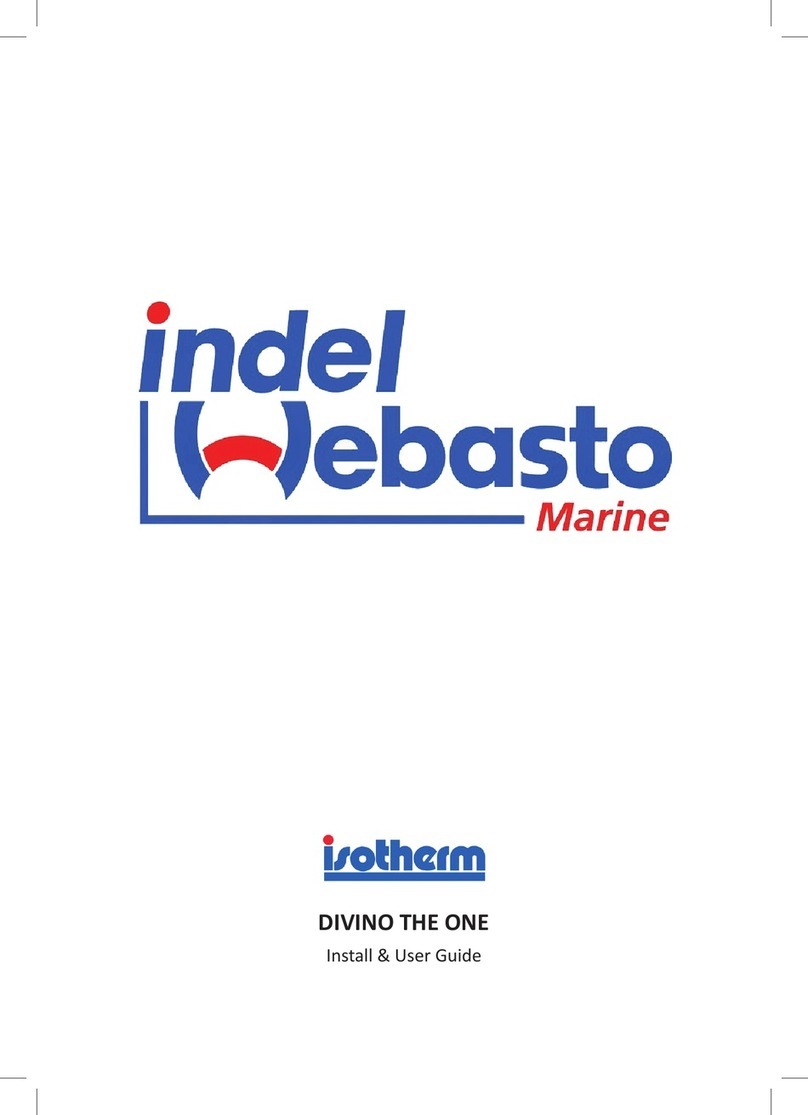
Indel Webasto
Indel Webasto isotherm DIVINO THE ONE Install & user's guide

Grand Cru
Grand Cru Pro GC194P Instructions & care manual

Eurocave
Eurocave 6182V Technical manual
